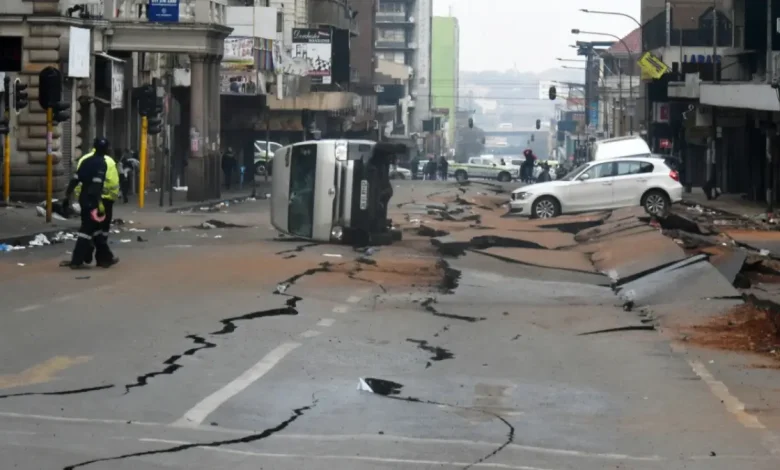JRA: Lilian Ngoyi Street Rehab Phase 1 Nearing Completion by August 2025

Table of contents
- Progress Report on Lilian Ngoyi Street Rehab Phase 1
- Key Safety Infrastructure Being Installed
- Extended Construction Hours to Minimize Disruption
- Economic Boost Through Jobs and SMME Participation
- Roads to Reopen After Phase 1 Completion
- What to Expect in Phase 2 Starting September 2025
- Enhancements for Pedestrian and Public Transport Facilities
- Managing Traffic with Rolling Closures and Detours
- Community Cooperation and Future Outlook
Lilian Ngoyi Street, a vital artery in Johannesburg’s inner city, undergoes a major transformation. The Johannesburg Roads Agency (JRA) confirms that the first phase of the street’s rehabilitation is on track for completion by the end of August 2025. This project, backed by a substantial R192 million budget, targets areas between Harrison and Kruis streets. Despite challenging weather conditions earlier this year, the work has advanced rapidly, paving the way for safer streets and improved urban infrastructure. The area’s residents, businesses, and daily commuters stand to benefit significantly as this critical upgrade nears completion.

ALSO READ: Gauteng’s Roads and Suburbs at Risk: Illegal Mining Tunnels Cause Collapse and Chaos
Progress Report on Lilian Ngoyi Street Rehab Phase 1
The contractor has completed 86% of the Phase 1 construction scope, demonstrating exceptional efficiency. Moreover, they have finished key structural tasks such as reinforced tunnel construction, backfilling, and compaction, signaling strong momentum. This steady progress reflects the team’s dedication to meeting deadlines despite earlier weather challenges. As a result, the project stays firmly on track to finish Phase 1 by the end of August 2025. The community can already anticipate safer streets and improved traffic flow once this phase wraps up. Pavement layers and essential safety installations are now the main focus. This steady progress means the city can meet the ambitious deadline without compromising quality or safety.
“The contractor has performed exceptionally well in ensuring that the projected timelines are met, despite adverse weather conditions earlier in the year,” said JRA CEO Zweli Nyathi.
Key Safety Infrastructure Being Installed
An important highlight of the rehab includes the installation of safety systems such as gas, heat, and smoke detection equipment inside newly built tunnels. These measures are currently 60% complete and are vital for monitoring hazardous gas levels and ensuring proper ventilation. These advanced safety features aim to prevent potential gas-related incidents, offering peace of mind to motorists and pedestrians who use Lilian Ngoyi Street daily.
“A robust work plan was developed by extending the daily construction hours.
“Additionally, pavement construction work is undertaken in the evenings to ensure minimal foot-traffic disturbance,” Nyathi explained.
Extended Construction Hours to Minimize Disruption
To accelerate progress while limiting the impact on pedestrians and local businesses, construction hours have been extended to evenings and weekends. This strategy ensures that daytime foot traffic and vehicle movement face minimal disturbance. By adopting this plan, the JRA balances swift project completion with community convenience, reducing any potential negative effects during the rehab period.
Economic Boost Through Jobs and SMME Participation
The first phase has injected approximately R64 million into the economy, with 27 small, micro, and medium enterprises (SMMEs) benefiting from contracts. Additionally, 38 workers are employed directly on site, highlighting the project’s role in stimulating local economic opportunities. This rehab not only improves infrastructure but also supports livelihoods in the Johannesburg community. By prioritizing local SMMEs, the project fosters entrepreneurship and business growth in the area. Furthermore, the ongoing employment opportunities contribute to reducing unemployment rates among residents. Overall, the initiative strengthens both the economy and social fabric of Johannesburg’s inner city.
Roads to Reopen After Phase 1 Completion
Once Phase 1 wraps up, Lilian Ngoyi Street along with adjoining north-south streets such as Joubert, Rissik, and Eloff will reopen to traffic. This reopening will enhance mobility in the inner city, relieving congestion and restoring essential routes. The anticipation of accessible, safer roads marks a turning point in this urban renewal project. As traffic flow improves, commuters and businesses will experience smoother daily operations. Additionally, the renewed streets will encourage increased economic activity in the area. Ultimately, this milestone paves the way for further developments in Johannesburg’s infrastructure upgrades.
CHECK OUT: Diepkloof Interchange Protests Cause Major Road Closures and Traffic Disruptions, Says JMPD
What to Expect in Phase 2 Starting September 2025
The rehabilitation’s second phase is set to commence in September 2025 and will continue until August 2026. It will cover an additional 1.8 km stretch between Ntemi Piliso and End Streets. This next stage follows the City of Johannesburg’s Inner City Transport Master Plan, focusing on improving public transport facilities and pedestrian mobility alongside road upgrades.
Enhancements for Pedestrian and Public Transport Facilities
Phase 2 will introduce wider walkways, safer zones for passenger loading and unloading, and the creation of a transit mall. These improvements aim to promote safer, more convenient public transport use and encourage pedestrian safety. By reshaping this urban space, the project supports a more sustainable and user-friendly city environment.
Managing Traffic with Rolling Closures and Detours
To reduce traffic disruption during ongoing works, the City will apply a block-by-block closure system. This approach allows refurbishment to proceed smoothly while maintaining traffic flow on intersecting roads. For example, detours for east-west traffic will involve alternative routes like Rissik and Loveday streets. West-east travelers will use Wanderers and Plein streets. Communication and clear signage are prioritized to assist drivers and minimize confusion.
Community Cooperation and Future Outlook
JRA expresses gratitude to residents, businesses, and commuters for their patience throughout the construction period. Continued community support remains vital as the city embarks on the second phase of this key urban upgrade. With careful planning and ongoing collaboration, Lilian Ngoyi Street’s transformation promises to significantly enhance Johannesburg’s infrastructure for years to come.




